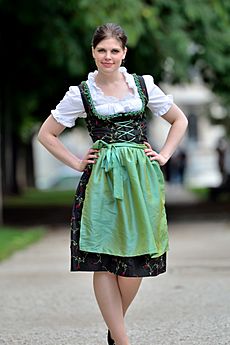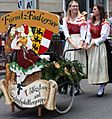Dirndl facts for kids
A dirndl is a special type of dress worn by women. You can see it in countries like Germany, Switzerland, Liechtenstein, Austria, and South Tyrol (which is part of Italy). This beautiful dress looks like the traditional clothes that farmers and people living in the Alps mountains used to wear a long time ago.
The word Dirndl first meant "girl" in the Bavarian language. Today, it can mean either the dress itself or a young girl. Sometimes, it was also called a Dirndlgewand.
Contents
What is a Dirndl?
The dirndl is a traditional dress that has been around for many years. It is often worn for special events, festivals, and celebrations. People wear them to show their cultural heritage and pride.
How Did Dirndls Start?
In the 1800s, young women who worked in homes (like housekeepers) wore dresses that looked very similar to dirndls. These early dresses were quite simple and plain. They were made for everyday work.
What Does a Dirndl Look Like?
A dirndl usually has a few main parts:
- A close-fitting top or bodice.
- A wide skirt that reaches different lengths.
- A dirndl blouse worn underneath.
- An apron worn over the skirt.
The style of the dirndl changed with the seasons. In winter, people wore heavy, often dark-colored dresses. These had long-sleeved blouses and thick aprons to keep warm. In summer, lighter versions were popular. Summer dirndls had short, puffed-sleeve blouses. Different styles of dirndls were worn in different regions. Each region had its own unique look.
The Apron Bow Secret
The way a woman ties the bow on her dirndl apron can tell you something about her.
- If the bow is tied on the left side (from her point of view), it means she is single.
- If the bow is tied on the right side, it means she is not single. She might be married, engaged, or in a relationship.
Images for kids
See also
 In Spanish: Dirndl para niños
In Spanish: Dirndl para niños















